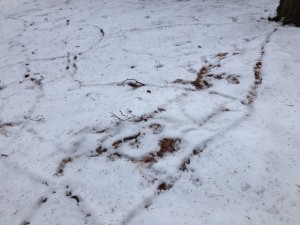It’s Only Natural
A Harsh Winter’s Effect on Local Wildlife
By Lindsey Pizzica Rotolo
I came home one bone-chilling February night to find a vole half-submerged in a marrowbone that I had given my dog earlier in the day. It was my first nonavian wildlife sighting since December. The average temperature had been less than 15 degrees for three solid weeks, so how was that thing alive?
It turns out that voles and moles are actually the big winners when it comes to surviving a harsh winter. Voles are Connecticut natives, and well adapted to cold temperatures and deep snow cover. They burrow at the end of long tunnels, so heavy snowfall provides more insulation and better protection from predators. As long as they have some food stored, or nutrient-dense bone marrow ripe for the taking, they do just fine.Other burrowers also fare well. Chipmunks, whose burrows can be as long as 30 feet and as deep as three feet, are also well protected from the elements and predators. They go into a semihibernation, only waking to eat stored nuts and seeds.
Squirrels, who nest in tree cavities during harsh winters, are also well protected. But their survival depends largely on the previous fall’s acorn season. If acorns were not abundant, squirrel populations diminish after a harsh winter. Reports about 2014’s acorn yield vary greatly throughout the state, but acorn production is typically good after a cool, wet summer. As a result, the yield was probably decent in Norfolk, which had a rainy summer, but abysmal in southern Connecticut, which was in a drought much of the summer season.
As for how the bigger animals fare, foxes, whose population declines as coyote populations grow, have a hard time with deep snow cover. Even though they are burrowers, they don’t semihibernate and therefore need to find food all winter long, which can be a struggle as the snow piles up.
Coyotes are also active all winter. They eat just about anything, but prefer smaller animals, so when their favorite prey are well protected by big snowfalls, coyotes turn to deer for their primary food supply. Connecticut coyotes breed in the winter months, which makes the males more aggressive than at other times of the year—another obstacle for the white-tailed deer.
Deer health entering the winter, like that of squirrels, is largely dependent on the fall’s acorn supply. Although they happily feed on twigs and bark from conifer trees all winter (and white pine and hemlock are abundant in Norfolk), the nutrition deer receive from acorns in the fall is of utmost importance to their diet. Acorns are high in fat and carbohydrates, and easy to digest, so deer can eat bushels of them a day. In a short period of time, deer can put on a nice layer of fat before the cold weather sets in.
Hopefully, that was the case for our deer this fall, because other factors may have limited their chance of survival this winter, particularly the amount of snow. Deer are surprisingly unable to move well in deep snow. Those long legs are actually not that strong, so it takes an incredible amount of energy for them to get around in even just a foot of snow. The deeper the snow cover, the more likely deer are to cluster in conifer groves, which makes them easy targets for coyotes. Of course, no wildlife expert is losing any sleep over this. They seem to be in agreement that the deer population after this winter is probably approaching ideal.
The best thing people can do to help wildlife during a harsh winter is to be aware of where animals are taking shelter and avoid those areas. As beautiful and serene as hemlock groves are in the dead of winter, keep your distance from them while snowshoeing and skiing. Approaching those areas forces animals to expend essential energy fleeing us, instead of conserving it for when they need to flee a predator. After all, it’s only natural.
Photo by Wiley Wood

